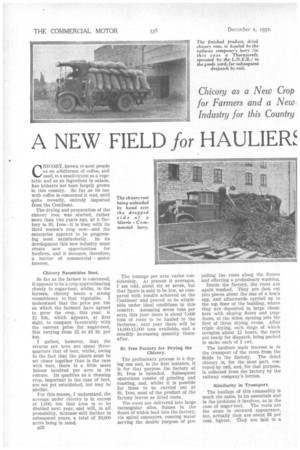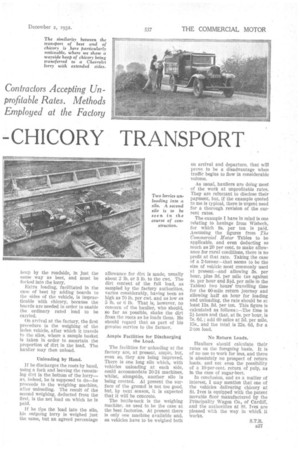A NEW FIELD for HAULIER
Page 44

Page 45

If you've noticed an error in this article please click here to report it so we can fix it.
-CHICORY TRANSPORT
CFIICORY, known to most people as an adulterant of coffee, and used, to a small extent as a vegetable and as an ingredient in salads, has hitherto not been largely grown in this country. So far, as its use with coffee is concerned it was, until quite recently, entirely imported from the Continent.
The drying and preparation of the chicory root was started, rather more than two years ago, at a factory in St. Ives—it is busy with its third season's crop now—and the enterprise appears to be progressing most satisfactorily. In its development this new industry must create new opportunities for hauliers, and it becomes, therefore, a matter of commercial motor interest.
Chicory Resembles Beet.
So far as the farmer is concerned, it appears to be a crop approximating closely to sugar-beet, whilst, to the layman, chicory bears a strong resemblance to that vegetable. I understand that the price per ton on which the farmers have agreed to. grow the crop, this year, is £2 10s., which appears, at first sight, to compare favourably with the current price for sugar-beet, this varying from £2 to £2 2s. per ton.
I gather, however, that the returns per acre are about threequarters that of beet, whilst, owing to the fact that the plants must be set closer together than is the case with beet, there is a little more labour involved per acre in its culture. Its qualities as a cleaning crop, important in the case of beet, are not yet established, but may be similar.
For this season, I understand, the acreage under chicory is in excess of 1,000, but that area is to be doubled next year, and will, in all probability, increase •still further in subsequent years, a total of 10,000 acres being in mind, B26 The tonnage per acre varies considerably. At present it averages, I am told, about six or seven, but that figure is said to be low, as compared with results achieved on the Continent and proved to be attainable under ideal conditions in this country. Assuming seven tons per acre, this year there is about 7,000 tons of roots to be hauled to the factories ; next year there will be 14,000-15,000 tons available, and a steadily increasing quantity thereafter.
St. Ives Factory for Drying the Chicory.
The preliminary process is a drying one and, in the first instance, it is for that purpose the factory at St. Ives is intended. Subsequent operations consist of grinding and roasting, and, whilst it is possible for those to be carried out at St. Ives, most of the product of the factory leaves as dried roots.
The roots are delivered into large rectangular silos, flumes in the floors of which lead into the factory, via spiral conveyors, running water serving the double purpose of pro
pelling the roots along the flumes and effecting a preliminary washing.
Inside the factory, the roots are again washed. They are then cut into pieces about the size of a hen's egg, and afterwards carried up to the top floor of the building, where they are deposited in large chambers with sloping floors and trapdoors, at the sides, opening into the first of three drying ovens. After triple drying, each stage of which occupies about 12 hours, the roots are ready for dispatch, being packed in sacks each of 1 cwt.
The hauliers main interest is in the transport of the roots from the fields to the factory. The dried chicory is, for the most part, conveyed by rail, and, for that purpose, is collected from the factory by the railway company's lorries.
Similarity in Transport.
The haulage of this commodity is much the same, in its essentials and in the problems it involves, as in the case of sugar-beet. The roots are the same in outward appearance, but, actually they are about 33 per cent. lighter. They are laid in a heap by the roadside, in just the same way as beet, and must be forked into the lorry.
Extra loading, facilitated in the ease of beet by addingboards to the sides of the vehicle, is impracticable with chicory, because the boards are needed in order to enable the ordinary rated load to be carried.
On arrival at the factory, the first procedure is the weighing of the laden vehicle, after which it travels to the silos, where a sample basket is taken in order to ascertain the proportion of dirt in the load. The haulier may then unload.
Unloading by Hand.
If he discharges the roots by hand, using a fork and leaving the remaining dirt in the bottom of the lorry— as, indeed, he is supposed to do—he proceeds to the weighing machine, after unloading. The result of the second weighing, deducted from the first, is the net load on which he is paid.
if he tips the load into the silo, his outgoing lorry is weighed just the same, but an agreed percentage allowance for dirt is made, usually about 2 lb, or 3 lb. to the cwt. The dirt content of the full load, as sampled by the factory authorities, varies considerably, having been as high as 70 lb. per cwt. and as low as 5 lb. Or 6 lb. That is, however, no concern of the haulier, who should, so far as possible, shake the dirt from the roots as he loads them. He should regard that as part of his genuine service to the farmer.
Ample Facilities for Discharging the Load.
The facilities for unloading at the factory are, at present, ample, but, even so, they are being improved. There is one long silo which, with vehicles unloading at each side, could accommodate 20-24 machines, whilst, alongside, another silo is being erected. At present the surface of the ground is not too good, but, by next season, it is expected that it will be concrete.
The bottle-neck is the weighing machine, as used to be the case at the beet factories. At present there is only one machine available and, as vehicles have to be weighed both on arrival and departure, that will prove to be a disadvantage when traffic begins to flow in considerable volume.
As usual, hauliers are doing most of the work at unprofitable rates. They are reluctant to disclose their payment, but, if the example quoted to me is typical, there is urgent need for a thorough revision of the current rates.
The example I have in mind is one relating to haulage from Wisbech, for which 8s. per ton is paid. Assuming the figures from The Commercial Motor Tables to be applicable, and even deducting so much as 20 per cent, to make allowance for rural conditions, there is no profit at that rate. Taking the case of a 2-tonner—that seems to be the size of vehicle most commonly used at present—and allowing 3s. per hour, plus 3d. per mile (as against 4s. per hour and 3id. per mile in the Tables) two hours' travelling time for the 60-mile return journey and allowing half an hour for loading and unloading, the rate should be at least us. 3d. per ton. This figure is calculated as follows :—The time is 2i hours and that, at 3s. per hour, is 7s. 60.; add 60 miles at 3d. per mile, 15s„ and the total is 22s. 6d. for a 2-ton load.
No Return Loads.
Hauliers should calculate their rates on the foregoing basis. It is of no use to work for less, and there is absolutely no prospect of return loads, and not even the possibility of a 10-per-cent. return of pulp, as In the case of sugar-beet.
In conclusion, and as a matter of interest, I may mention that one of the vehicles delivering chicory at St. Ives is equipped with the patent movable floor manufactured by the Principality Wagon Co., of Cardiff, and the authorities at St. Ives are pleased with the way in whicli it works.




































































































